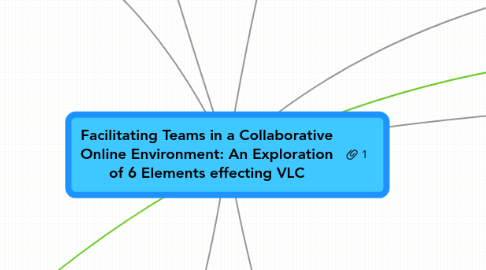Facilitating Teams in a Collaborative Online Environment: An Exploration of 6 Elements effecting VLC
by James Wanless

1. Dominant Presence
1.1. Resource Attachment
1.2. STRATEGIES
1.3. Self Reflection: Impact of Self on Others
1.4. Well Structured task, social & cognitive processes
1.5. Explore "leading opinion" vs "dominance"
1.6. Pre-empt through design, supportive activites, strong teacher presence, & discourse
1.7. Shared accountability for group dynamics
1.8. Establish clear guidelines for tone, language & content in discourse
2. Cyberstress
2.1. Resouce Attachment
2.2. STRATEGIES
2.3. Know & optimize peer styles/skills, habits, preferences
2.4. Take time to establish clear roles & responsibilities
2.5. Develop level of comfort with technology
2.6. Clear instructional platform, advance scheduler
2.7. Create comfort zone online e.g.: video intros, intro social activities, reward risk taking, scaffolding activites, mentorship relationships
2.8. Read/take the pulse of cohort stress levels as course evolves - may need to redesign
2.9. High Facilitator presence, models flexible attitude toward glitches, disruptions, modicum of humour
3. Conflict/Personal Attack
3.1. Resource Attachment
3.2. STRATEGIES
3.3. Intro & Establish Ground Rules
3.4. High Facilitator Presence synchrononous & asynch. Intervention: confidential contact, offer other viewpoint, highlight areas of commonality
3.5. Be explicit in asking for cues to understanding position
3.6. Explicitly explore issues such as "academic tone", "absences/silences"
3.7. Expect conflict: take care not to over-react and squash lively debate in opposing views
4. Acknowledge that conflict is a postive dynamic
5. Sustaining Motivation
5.1. STRATEGIES
5.2. Resource Attachement
5.3. Advance Scheduler as intro - facilitator continues to engage, monitor, guide interactivity
5.4. Take pulse: surveys, private/public interactions,
5.5. Reinforce concept of shared accountability for learning
5.6. Design for & build social presence: Create safe, fun & comfortable "space" while encouraging deeper discourse
5.7. Explore any issues for "silence"/apparent disengagement e.g. need for reflection time on readings, religious observances etc.
5.8. Be explicit in expectations, learning outcome measurements, grades, number of postings etc
5.9. Initiate unexpected changes to environemnt/methods of presentation, create unusual content, problems, games, quizzes, humour
6. Arriving @ Team Consensus
6.1. STRATEGIES
6.2. Resource Attachment
6.3. Consistent, clear, explicit expectations, advance scheduler
6.4. Restate learning outcomes, , stress importance of discourse, ensure communication tools are acccessible
6.5. Offer guidelines re: conflict resolution, develop team charter, protocols for communication
6.6. Evenly balance team talents
6.7. Facilitator interventions scale: soft, hard, shock & awe
7. Social Loafing/Easy Riding
7.1. STRATEGIES
7.2. Resource Attachment
7.3. Consistent, clear, explicit learning & assessment expectations, advance scheduler
7.4. Confidential Peer Assessment reflecting on specific categories
7.5. Quantity vs Quality debate worthwhile
7.6. Shared accountability for negotiating "prescribed" frameworks and arrive at resolution
7.7. Design of Social Presence
7.8. Revisit roles, responsibilities, expectations
7.9. Strong teacher presence & meaningful activities


